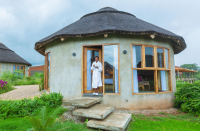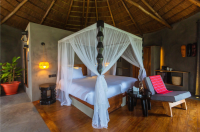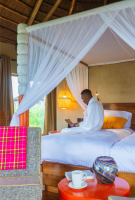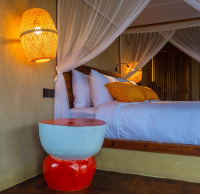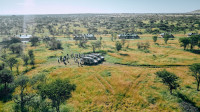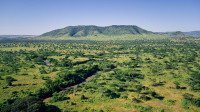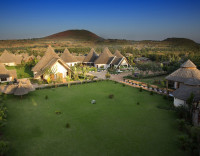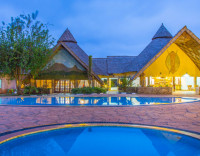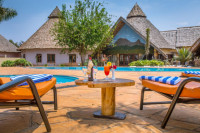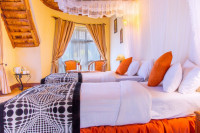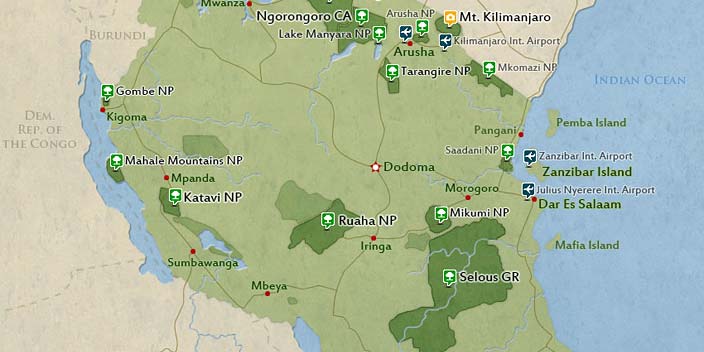
$2,050 pp (USD)
2 travelers on Start dateArrival
Arrival

Day 1
Arusha to Tarangire National Park
Arusha to Tarangire National Park
We will pick you up from your hotel early in the morning after breakfast. We then depart for Tarangire National Park, named after the Tarangire River, which is the sole water source for wildlife in the region during the dry season. Known for its dense vegetation, including elephant grass and acacia woodlands, the park is famous for its large elephant families often seen by the river. You might also spot giraffes, bushbuck, and hartebeest, along with predators like lions and leopards. Tarangire boasts the highest diversity of breeding bird species in the world and is home to Tanzania's largest elephant population, from playful calves to majestic bulls. After a packed lunch, we will head to our accommodation for dinner and an overnight stay at Suricata Boma Lodge.
- Main Destination:
- Tarangire National Park
- Accommodation:
- Suricata Boma Lodge
- Meals & Drinks:

Day 2
Ngorongoro Cater to Serengeti National Park
Ngorongoro Cater to Serengeti National Park
Early in the morning, after breakfast, we will depart for Ngorongoro Crater. Upon arrival, Ngorongoro Crater reveals itself as a lost world. Here, you’ll have the chance to spot the endangered black rhino and large prides of lions. Formed by a massive volcanic explosion and collapse two to three million years ago, the crater is renowned for its geological wonders and dense populations of large mammals. The drive into the crater is an adventure, and once on the floor, you'll encounter herds of wildebeest, zebra, and gazelle, along with over 500 bird species. The crater offers the best opportunity to see the elusive black rhino in the open grass. After a packed lunch, we'll continue to Serengeti National Park for dinner and an overnight stay at Land of Nature.
- Main Destination:
- Ngorongoro Crater
- Accommodation:
- Land of Nature Camp
- Meals & Drinks:

Day 3
Full game Drive Serengeti National Park
Full game Drive Serengeti National Park
We’ll start with an early breakfast before setting off on our game drive around 6:30 am, giving us 6 to 7 hours to explore the remarkable Serengeti. This park is home to a diverse range of wildlife, including impalas, buffalo, crocodiles, and hippos. However, it's best known for the massive migrating herds: 250,000 zebras, 1.5 million wildebeests, and 500,000 antelopes. These migrations are influenced by rainfall patterns and vary each year. In addition to the migrating herds, we may encounter predators like leopards, cheetahs, and lions on the hunt.
- Main Destination:
- Serengeti National Park
- Accommodation:
- Land of Nature Camp
- Meals & Drinks:

Day 4
Serengeti National Park to Karatu
Serengeti National Park to Karatu
We’ll begin with an early breakfast and depart for our game drive around 6:30 am, allowing us 6 to 7 hours to explore the incredible Serengeti. The park is home to a variety of wildlife, including impalas, buffalo, crocodiles, and hippos, but it is especially famous for its massive migrating herds: 250,000 zebras, 1.5 million wildebeests, and 500,000 antelopes. These migrations are driven by rainfall and vary each year. In addition to the herds, we may encounter predators like leopards, cheetahs, and lions in action. Around 2:00 pm, we’ll drive back to Karatu, arriving at our selected mid-range lodge for dinner in a beautifully appointed restaurant. You can relax by the pool, enjoy a drink by the fire under the endless African sky, and settle into your spacious quarters for a restful night with dreams of wild cats. Overnight at Farm of Dream Lodge.
- Main Destination:
- Serengeti National Park
- Accommodation:
- Farm of Dreams Lodge
- Meals & Drinks:

Day 5
Lake Manyara National Park to Arusha
Lake Manyara National Park to Arusha
We’ll start the day with an early breakfast at the lodge before making a short drive to Lake Manyara National Park. Located 120 km west of Arusha, this relatively small but diverse park is named after the shallow salt lake that covers about 70% of its area. Seasonally flooding and drying, the soda lake attracts thousands of flamingos and over 500 other bird species. As we explore the park, we'll encounter monkeys, giraffes, zebras, wildebeests, buffalo, elephants, and, if we’re lucky, tree-climbing lions. The park is renowned for its varied landscapes, featuring open grassy plains, primate-filled woodlands, and baobab-studded cliffs. After a packed lunch, we’ll return to Arusha, where our adventure concludes.
- Main Destination:
- Lake Manyara National Park
- Accommodation:
- No accommodation (End of tour)
- Meals & Drinks:















